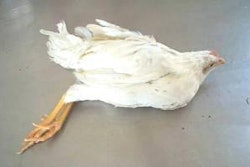Egg Industry will continue to document cases which are encountered in practice representing problem areas in commercial production and processing. Readers are encouraged to submit their comments and to share cases.
A review of production records from a flock of 14,000 floor-housed brown-feathered hens demonstrated acceptable egg production, livability and weight gain for the first five weeks of the production cycle. Thereafter there was a pause in production over a week followed by a reduction of 13% over the next three weeks. Over this period an elevation in mortality occurred and body weight gain initially plateaued and then declined. The production manager, noting the decline in performance visited the farm during the 30th week to investigate the problem.
The flock showed uneven distribution over the floor area with a higher proportion of hens on the left side of the house. Passing down the house it was noted that there was virtually no feed in the trough of the right hand circuit compared to a normal depth of feed in the left circuit.
Faulty mechanics reduce production
This discrepancy was caused by a defective hopper level limit switch, activating the cross auger from the feed bin. Effectively this restricted delivery of feed to the right hand circuit. The result was increased competition for feed since hens were forced to eat from only one of the two circuits. The consequence was reduced weight, a concurrent drop in hen week production and an increase in mortality.
Replacement of the defective limit switch resulted in even distribution of feed in the house and resolution of the problem. It is estimated that losses amounted to 4,400 dozen eggs valued at $3,300 over the approximately six-week period when the feeding system was defective.
This case illustrates the need to systematically inspect houses at least twice daily observing for any abnormalities in function of ventilation, feeding, lighting or watering systems and noting the clinical appearance and behavior of flocks. Weekly evaluation of accurate flock records is essential to detect deviations from predetermined production standards.

















